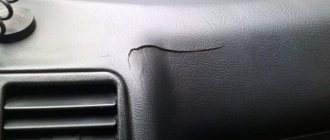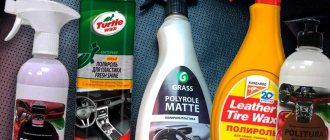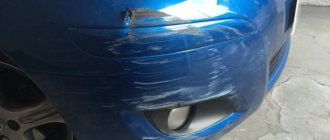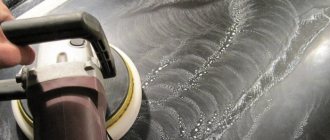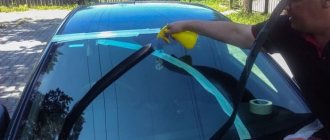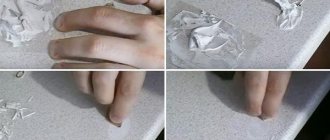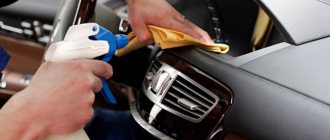Polymer materials are distinguished by their lightness, beauty and plasticity. The range of their applications covers all types of industry, housing and communal services and the service sector. People deal with plastic in the form of housings for small, medium and large household appliances, finishing materials and cladding of vehicles. During operation, products are subject to damage that spoils their appearance. Polishing plastic yourself is a way to return a scratched surface to its original smoothness and presentability with minimal investment and effort.
Preparation for the process
Before starting work, you need to inspect the object to identify the extent and nature of its damage. This is necessary in order to choose the optimal method of repair to achieve the desired effect.
In order to get rid of external defects, you can use one of the following methods:
- Thermal. It consists of a thermal effect on the material, as a result of which it loses its hardness and becomes viscous.
- Mechanical. To polish plastic from scratches at home, abrasive agents are used to grind off uneven surfaces.
- Chemical. Substances are used that change the structure of the plastic or fill all the cavities on its surface. After the end of the action of the drugs, the surface becomes one with them.
After choosing a repair method, you should prepare the workplace and the damaged object. It should be restored on a table covered with oilcloth or cellophane. The product itself is cleaned of dirt and washed. To do this, it is better to use dishwashing detergent and a soft brush. After the surface is cleaned, it should be wiped dry with a natural cloth. If the polymer is enclosed in a metal or wooden frame, then it must be covered with mounting tape to prevent damage by a reagent or abrasive.
For safety reasons, polishing plastic with your own hands should be carried out wearing skin, vision and respiratory protection. It is necessary to prepare rubber or fabric gloves, assembly glasses and a gauze bandage.
How to properly remove scratches from gloss
Transparent plastic is used in the design of many interior elements. The disadvantage of this material is the rapid appearance of defects: small scratches and chips, after several years of operation of the car, literally cover the entire surface of the interior element. Removing scratches from car interior plastic has a number of nuances:
- Before carrying out restoration, you need to wet clean the car interior. It is necessary to ensure that there is no dust. Otherwise, new scratches may appear on the surface during polishing.
- The area to be treated will need to be thoroughly washed and degreased.
- To get rid of scratches, use a sanding machine.
- To polish the damaged area, it is recommended to use products that are designed for polishing plastic. These are special polishes and abrasive pastes. It is important to correctly calculate the amount of substance applied.
Abrasive pastes, gels and polishes, which are intended for polishing the car body, cannot be used when restoring the interior. They will ruin the part being restored.
Numerous defects, scratches, chips and cracks spoil the appearance of the car dashboard. Damage of this kind can be easily repaired on your own. To ensure that the repair process is effective and does not lead to replacement of the part, take into account the nuances of restoring the plastic elements of the interior.
We recommend: How to remove the instrument panel on a VAZ-2114 in 12 steps? Features and detailed instructions
Sanding plastic from deep scratches
Deep scratches are difficult to repair with putty, as burrs and the elasticity of the grout itself interfere with this. In addition, it is not always possible to choose a material of the desired color, which will not be visible after hardening. It should be taken into account that polymer plastic is soft and easily grinds off. The main condition is to maintain a low surface temperature of the product during the restoration process. Strong friction with a high amplitude of movement causes heating and melting of the synthetic mass.
To work you will need the following tools and equipment:
- sandpaper of different grain sizes;
- handmade grater;
- grinding machine of any operating principle;
- soft brush;
- soap;
- rags.
It is recommended to grind plastic using the following method:
- Secure the product to a solid and stable base. You can use a vice, clamps and self-tapping screws.
- Attach the coarsest sandpaper to a hand or power tool.
- Moisten the surface to be treated with soapy water. This will reduce friction and prevent it from overheating.
- Using gentle pressure, use circular movements to treat the damaged area, covering 1-2 cm of the clean area.
- As the polymer grinds down, change the nozzles, gradually reducing the grain size. Perform the final stage with zero.
- Rinse off the liquid and check the quality of the work performed. If necessary, repeat the procedure.
The result should be a smooth matte surface with a uniform texture. After this, the material is brought to the desired state using more delicate means.
How to polish plastic from scratches yourself
If abrasions and scratches appear on the surface of the plastic, it is not necessary to throw away the old one and buy a new product. There are several effective techniques that can be used to polish glossy plastic to a mirror finish. To do this, you can use factory-made and home-made preparations, and various improvised means.
The effort spent will pay off, since the services of repairmen or replacement of a product can cost a considerable amount. The right approach will provide good savings and the acquisition of precious experience that will come in handy more than once.
Hand polishing
This procedure is carried out in cases where the surface has shallow cracks, abrasions, or has been subjected to a primary sandpaper treatment. The material is exposed to an abrasive with microscopic grains, traces of which can only be seen with a magnifying glass. Similar services are provided by auto repair shops and cleaning companies, but their price is comparable to purchasing a new product. It is cheaper to restore plastic yourself and for free.
The abrasives used are GOI paste, tooth powder, ash and fine volcanic dust, which can be purchased at pet stores. Felt, felt, wool and batting are best suited for the nozzle. The fabric is moistened with alcohol or water, after which an abrasive is applied to it. To polish the plastic to its original state, you need to wipe the products with smooth movements and even, gentle pressure.
The advantages of this method, compared to the mechanical one, are that there is no chance of the material melting or being damaged by careless movement. In addition, the sense of touch ensures high processing accuracy.
Polishing
If you don’t have the necessary improvised and factory equipment in your home, you should remember about polish. This is a product consisting of an emulsion and tiny particles that grind down irregularities on the surface of plastic and glass products. Thanks to the thoughtful composition and proportion of components, a high-quality final result is achieved.
This paste for polishing plastic is used according to the following method:
- The substance is applied to the surface and distributed over it in an even layer.
- The object is wiped with a sponge or terry cloth. The degree of pressure is determined based on the hardness of the material and the depth of its damage.
- The product is rinsed under running cold water. If defects remain, the procedure must be repeated until the desired result is achieved.
A special feature of the polish is that it can be safely used when using mechanical brushes. The presence of lubricant prevents overheating, even when processing is carried out at high speeds.
Using a polishing machine
The tool belongs to the category of professional equipment, but has an affordable price for purchase in a home workshop. The device is characterized by ease of use and high performance, which is achieved by the high speed of rotation of the nozzles. Designed for the restoration of car plastic over a large area; it can also be used for other purposes when restoring housings of household appliances, window sills and worn glass.
During the polishing process, the following rules must be observed:
- Before starting work, clean the area from dirt, dust, grease and oil deposits. To do this, use a tile and glaze cleaner.
- Start processing with the coarsest nozzle, which will remove the thin top layer of material. Then change attachments as you get closer to finishing the job.
- Finish the procedure with a foam nozzle, which will bring the final shine to the plastic, eliminating all the smallest abrasions.
The machine has proven itself well in the restoration of plumbing fixtures, window glass, window sills and even furniture varnish.
Hairdryer
Depending on the area of the damaged surface and its characteristics, a household or construction hair dryer is used. The principle of this method is that when heated, the transparent plastic becomes viscous. In this state, like water, it fills all the depressions, forming a flat plane.
The rules for using a hair dryer are as follows:
- No dirt or dust on the plastic.
- Checking the reaction of the material to heating in an inconspicuous area.
- Gradual warming up with a slow increase in power.
- Smooth movement of a jet of hot air over the area so as not to burn the polymer plate.
- If cracks persist, do not increase power to maximum as this may cause a fire.
If the work is done correctly, the result will be no worse than after lengthy and labor-intensive grinding. All abrasions will disappear, and in their place a shiny gloss will appear.
Toothpaste
As practice shows, polishing plastic with toothpaste, when done skillfully, can give results that are not inferior to patented products. For work, you should choose neutral compounds without acids and alkalis. You should pay attention to the size of the abrasive particles. The smaller they are, the better the surface will be leveled. If there is a large amount of work to be done, then it is advisable to purchase an inexpensive tube that can be used only for technical purposes. You can enhance the abrasive properties with fine dispersion dental cleaning powder.
Cleaning is done in this way:
- The product is prepared for processing.
- The paste is applied to felt or thick fabric.
- Polishing is carried out by making circular movements.
- As the composition becomes contaminated, it is removed and replaced with a fresh one.
- At the end of the treatment, the surface is washed under running water and wiped dry to avoid the formation of a white coating.
If you are going to restore transparent plastic, it is advisable to use a gel for sensitive teeth.
Removing small cracks
The following tools allow you to quickly eliminate minor cracks and at the same time preserve the condition of your wallet. Their effectiveness is based on the principle of polishing and preparatory work should consist of thorough cleaning of the surface being treated and its further drying.
Wax
Wax is used to polish plastic surfaces. It must be used in combination with soft, dry cloth. Movements during rubbing should be circular. A cotton swab will help get rid of excess wax. A good alternative to wax is GOI paste or machine oil.
Glass cleaning products
Glass cleaning products must be used according to the same principle. In combination with a dry cloth, the action of such compositions is quite effective in relation to minor scratches.
Glass polishes
Products used for polishing glass surfaces with abrasive components are also suitable for plastic. In the case of small scratches, this method not only masks them, but removes them completely. Hydrofluoric acid can act as an abrasive component, so if there are elements on the surface that are not made of plastic or glass, refrain from using this option.
Polish for copper and silver
Copper and silver polishes can be used in tandem with microfiber or a dry cloth. Rubbing should be continued until the trace of cracks is visually invisible.
Household or construction hair dryer
A household or construction hair dryer will allow you to quickly deal with a minor defect. Be sure to clean the surface and dry it. Start heating the area with the scratch with a hairdryer, but do not hold it in one place. Wait until the plastic begins to melt slightly. Do not touch the restored surface with your hands until it has cooled down.
We recommend: Changing the engine oil
Computer products
Tools for computer equipment and disks also demonstrate effectiveness. They are also convenient to use in combination with microfiber.
Polish for wood and plastic surfaces
Wood polish will also work on plastic, but it should be combined with Vaseline. The damaged area will be filled with this composition and the crack will not be so visible. Continue rubbing the surface until the Vaseline is completely absorbed.
Additionally, we recommend reading our specialist’s article on how to polish a car with your own hands.
Using Dye
Minor scratches can be dealt with with a dye designed specifically for masking this type of damage. It should be applied with a toothpick or thin brush. Polishing is carried out with machine oil.
You can find more detailed information on how to choose the right paint for plastic in the article by our specialist.
Fabric paint or masking markers
Fabric paint or masking markers are also effective, but require additional finishing polishing. Felt pens, if their quality is beyond doubt, can be quite expensive, but this method is very economical.
Types of pastes for polishing plastic
Commercially available polishing pastes for plastic vary in color, composition and purpose. According to these indicators, they can be used for processing hard and soft, matte and glossy surfaces. Based on this, before making a purchase you need to know exactly the characteristics of the object that will be processed.
Factory-made polishes are divided into the following categories:
- orange - rough, preparatory;
- yellow - pre-treatment;
- white – final polishing;
- blue - superfinish composition for hard materials;
- green – super finish for medium density materials;
- gray - intermediate for high-density plastic;
- black - super finish for delicate materials;
- red - super finish for transparent plastic.
To achieve the desired goal, the compositions can be mixed, which leads to the weakening of some properties and the strengthening of others.
The best recommendations from users were earned by such polishes as DIALUX VORNEX, Turtle Wax, SINTEC Cockpit Polish, Plak Super Mat, Nanox, GRASS.
